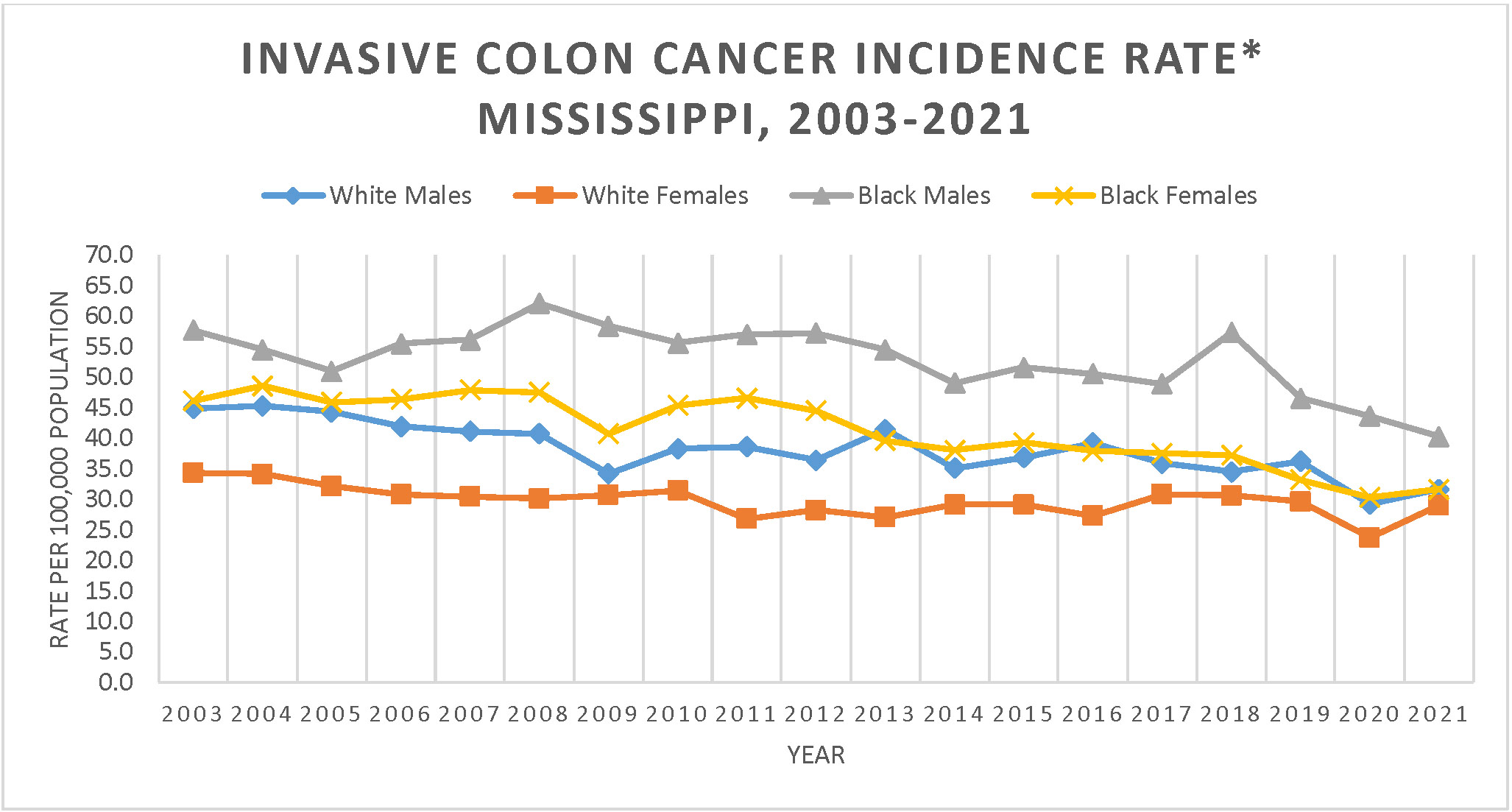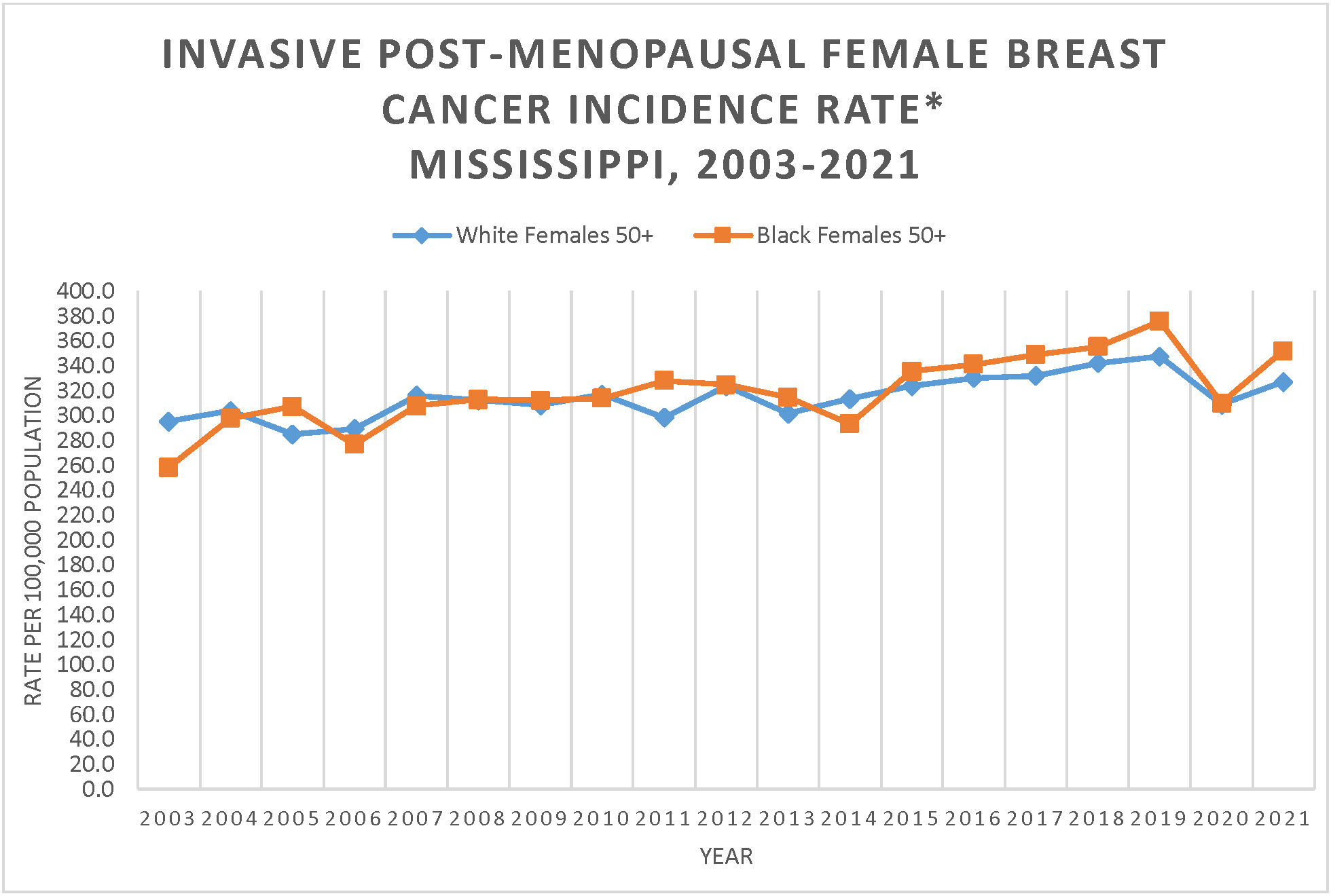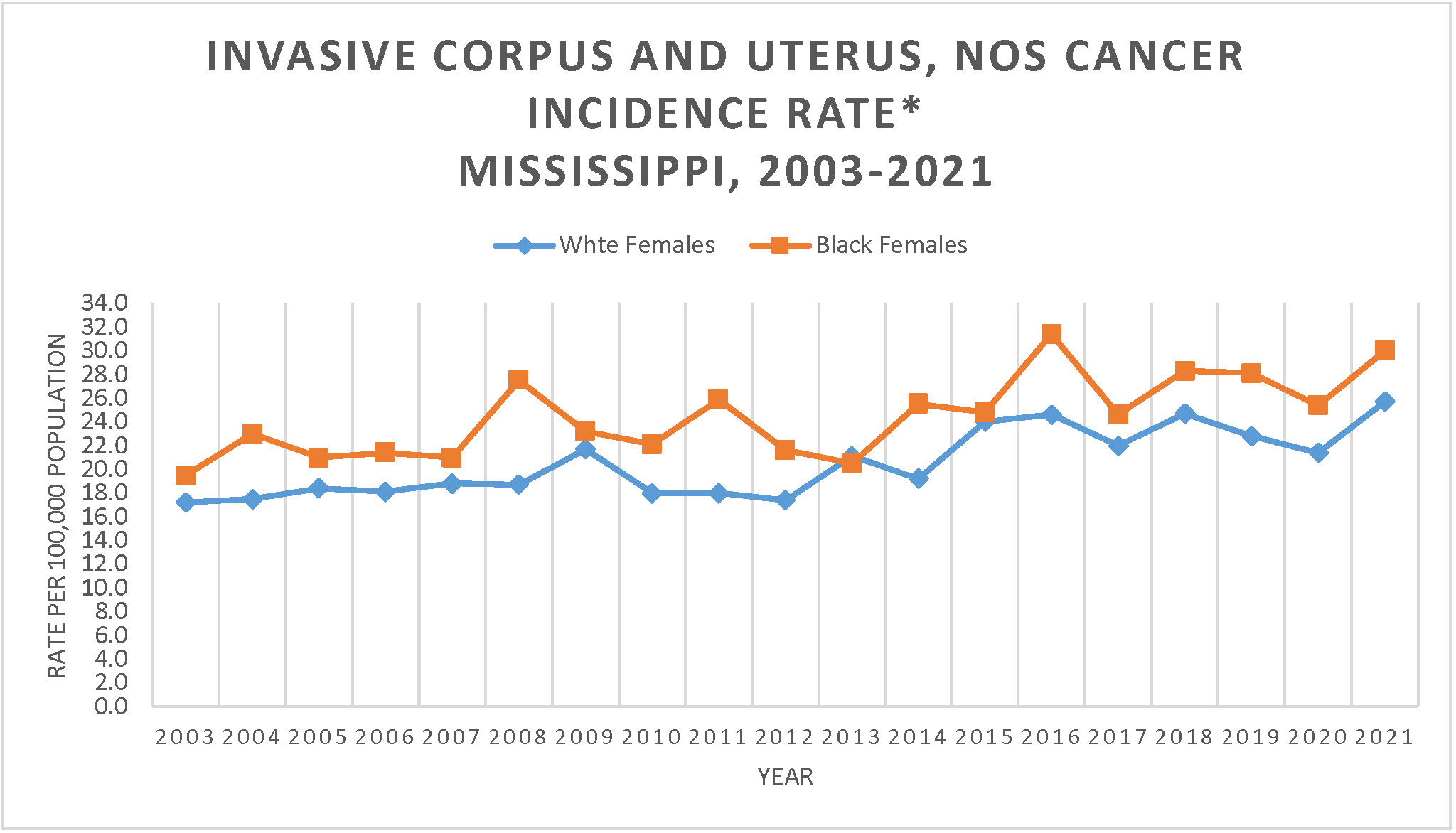- Cancer Institute
- Cancer Research
- Cancer Registries
- Mississippi Cancer Registry
- Data and Statistics
- Lifestyle-Related Cancers
Lifestyle-Related Cancers
- Cancer Center and Research Institute
- Contact Cancer Center and Research Institute
-
Cancer Research
- Cancer Research Home
-
Cancer Registries
- Cancer Registries Home
- UMMC Cancer Registry
- Mississippi Cancer Registry
- Clinical Trials
- For Students and Trainees
- Patient Support
- Give Now
- In the News
Physical Activity-related Cancers in Mississippi, 2003-2021
Lack of physical activity is a modifiable risk factor that increases the risk of developing certain cancers. According to data from the Behavioral Risk Factor Surveillance System for 2020, 68.1% of Mississippi adults over age 18 reported participating in any leisure-time physical activity Mississippi has the second lowest rate in the nation including the District of Columbia and Puerto Rico for participation in physical activity.1 Lack of physical activity is associated with developing cancers of the colon and uterus, as well as, development of breast cancer after menopause. Below are graphs of the trends in physical activity-related cancers over the period 2003 to 2021 by race and sex with a description of the trends occurring in each group both for the full time period and for the most recent period between 2017 and 2021. All analysis was done using SEER*Stat software2.

While colon cancer is associated with a lack of physical activity, it can also be associated with other modifiable risk factors, tobacco use, alcohol use, and obesity. Black males had significantly higher rates of colon cancer than white females for all years. Black males had significantly higher rates than black females in 2003 and again in 2008, 2009 and from 2011 to 2021. Black males also had significantly higher rates of colon cancer than white males for 2003 and for the time period from 2006 to 2021. The rate for white females was significantly lower than white males except for 2009, 2018, and 2021 and was significantly lower than for black females all years except 2019 and 2021. White males, black males, white females, and black females had statistically significant decreasing trends for the full-time period from 2003 to 2021. For white males, the decrease was 1.72% annually, and for white females, the decrease was 0.97% annually. Black males had an observed decrease of 0.62% between 2003 and 2018 and a significant decrease of 8.58% between 2018 and 2021. This led to an overall statistically significant average annual decrease of 2.0% over the full time period. Black females had an observed decrease of 0.67% annually between 2003 and 2011 and then a significant decrease of 3.55% annually between 2011 and 2021. This led to an overall significant average annual decrease of 2.3% over the full time period for black females.
For the latest five-year time period between 2017 and 2021, only black males had a statistically significant change which was a 6.45% decrease annually. All three other groups had decreasing trends for this time period. The annual decrease for white males was 4.09% and for black females was 5.44%. For white females, the observed decrease was 3.52% annually.

Post-menopausal breast cancer is defined as breast cancer diagnosed in women ages 50 and older. Not only is post-menopausal breast cancer associated with a lack of physical activity, it is also associated with another modifiable risk factor, obesity. Rates of post-menopausal breast cancer are similar between white females and black females. The rates of post-menopausal breast cancer between 2003 and 2021 increased significantly by 0.87% annually. The annual percent change for white females was a significant 0.71% and for black females was a significant 1.21%. For the most recent five-year time from 2017 to 2021, white females experienced an observed decrease of 1.27% annually. Black females also experienced an observed annual decrease over the period of 2013 to 2021 of 1.08%.

Uterine cancer is not only associated with a lack of physical activity, but is also associated with another modifiable risk factor, obesity. Uterine cancer rates increased significantly between 2003 and 2021. The annual percent change over that period of time was 2.01%. Black females experienced a significant increase of 1.79% annually, and white females experienced a significant increase of 2.00%. The trend over the latest five-year period from 2017 to 2021 for black females was an annual increase of 3.04% which was not statistically significant. For white females, there was an increase of 1.73% annually. Though black females have rates that are observed to be higher than white females for all years except 2013, these differences are only statistically significant for years 2004, 2008, 2011, 2014, 2016, and 2019.
Definitions
Age Adjusting: A statistical method that allows comparisons of populations that take into account age-distribution differences between the populations. The 2000 U.S. standard population is used and applied to all of the time periods being considered. This assures that the rates do not reflect differences in the age distribution of the population.
Annual Percent Change (APC): The average annual percent change over several years. It is used to measure the change in rates over time. Calculating the APC involves fitting a straight line to the natural logarithm of the data when it is displayed by calendar year.
Statistical Significance: This is a mathematical measure of the difference between groups. A difference is said to be statistically significant if it is greater than what might be expected to happen by chance alone 95% of the time. Rate ratios were used to assess the statistical significance between groups.
Citations
1Centers for Disease Control and Prevention, National Center for Chronic Disease Prevention and Health Promotion, Division of Population Health. BRFSS Prevalence & Trends Data [online]. 2022. [accessed Jun 3, 2024]. URL: https://www.cdc.gov/brfss/brfssprevalence/.
2Surveillance Research Program, National Cancer Institute SEER*Stat software (seer.cancer.gov/seerstat) version 8.4.3.
Acknowledgement
We acknowledge the Centers for Disease Control and Prevention for their financial support under a cooperative agreement awarded to the Mississippi Cancer Registry.


